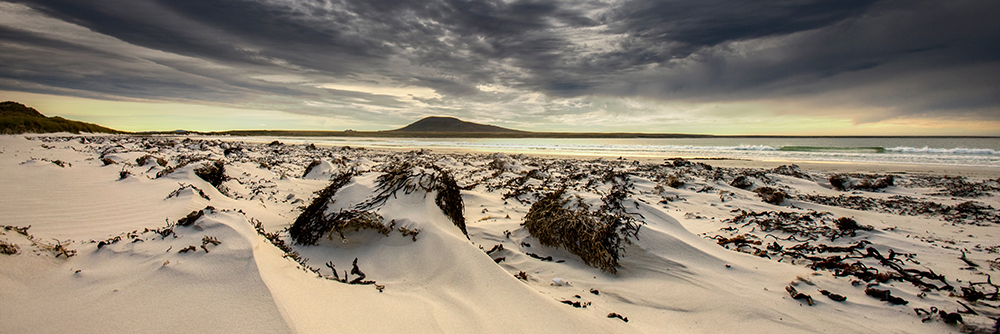PEBBLE ISLAND 51°18’S 51°38’W
Pebble is part of the north-west chain of islands including Saunders, Keppel, Carcass, West Point, and Sedge. 19 miles (30 km) long and 4.3 miles (7 km) wide at its widest the island is roughly divided into two sections joined by an isthmus. The western section is dominated by mountains, the highest, First Mountain is 909 ft (227 m), Middle 72 ft (214 m), and Marble 778ft (237 m). Overlooked by First Mountain, Pebble settlement is on the isthmus close to Elephant Bay with its spectacular 5 km white sand beach. The eastern part of the island is marshy with large ponds, an important habitat for waterfowl including grebe, waders and black-necked swans.
This is a working farm and the 2021 Government Farm Statistics for Pebble record that it is owned by A & D Gould, has a population of 5, and 141 beef and 5751 sheep.
Penguins found on Pebble include kings, rockhoppers, magellanics, gentoos and occasional erect-crested and macaronis. The island is named for the transuculent, semi-precious stones found on her beaches. The pebbles are sometimes credited from coming from nearby Marble Mountain.
A simple memorial cross on a cairn near First Mountain, west of Pebble settlement, remembers HMS Coventry, lost on 25th May 1982 during the Argentine/ British conflict when she was attacked by Argentine Skyhawks. During the 1982 Falklands war the island was occupied by 300 Argentine forces where they tried to form a naval air station. On the night of May 14th British SAS raided Pebble destroying 11 Argentine aircraft and retaking the island. On 25th May HMS Coventry was sunk 10 miles north of Pebble with the loss of 19 British lives.
|

 Four Mile Beach, Pebble Island- Steve Allen/Shutterstock.com
Four Mile Beach, Pebble Island- Steve Allen/Shutterstock.com